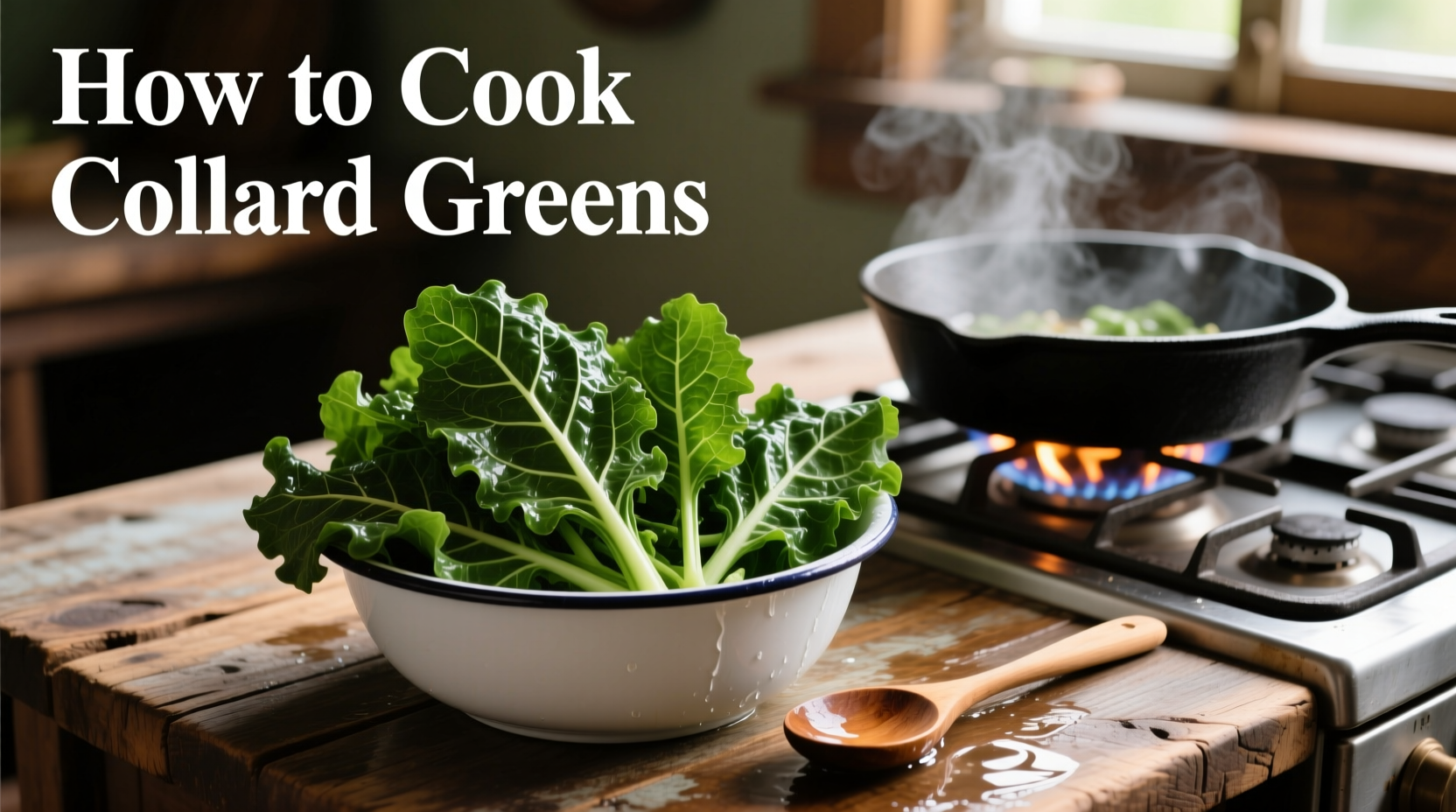Collard greens have nourished communities for centuries, from African traditions to Southern American soul food. Getting them right transforms these sturdy leafy greens into a comforting dish with deep flavor and ideal texture. Many home cooks struggle with bitter, undercooked, or soggy results—but with the right technique, you'll create collard greens that honor tradition while fitting modern tastes.
Preparing Collard Greens: The Foundation for Success
Before you start cooking, proper preparation determines your final outcome. Fresh collard greens should have crisp, deep green leaves without yellowing or wilting. Avoid pre-cut varieties which lose nutrients faster.
Washing technique matters most: Fill a clean sink or large container with cold water. Submerge leaves and swish gently to dislodge dirt. Drain and repeat until no grit remains—this typically takes 3-4 rinses. Never skip this step; field dirt hides between leaf layers.
Remove the tough central rib by folding each leaf in half lengthwise and slicing along the stem. Stack 5-6 leaves, roll tightly, and slice crosswise into 1-inch ribbons. This "chiffonade" cut ensures even cooking.

Cooking Methods Compared: Choosing Your Approach
Your cooking method affects texture, nutrient retention, and flavor development. Here's how common techniques compare:
| Method | Cooking Time | Texture Result | Nutrient Preservation |
|---|---|---|---|
| Traditional Simmer | 45-90 minutes | Fully tender, rich broth | Moderate (water-soluble vitamins leach into broth) |
| Quick Sauté | 10-15 minutes | Slightly crisp, vibrant color | High (minimal nutrient loss) |
| Pressure Cooker | 15-20 minutes | Uniformly tender | Good (shorter cooking preserves more nutrients) |
Traditional Simmering Technique: Step-by-Step
This time-honored method develops deep flavor and tender texture. Follow these steps for authentic results:
- Build flavor base: In a large pot, cook 4 oz smoked turkey necks, ham hocks, or vegan alternative with 1 diced onion and 3 minced garlic cloves for 5 minutes until fragrant
- Add greens in batches: Pack half the greens into the pot, stir until slightly wilted, then add remaining greens
- Pour in liquid: Add 4 cups broth or water just until greens are submerged (they'll shrink significantly)
- Season properly: Add 1 tsp black pepper, 1/2 tsp red pepper flakes, and 1 tbsp apple cider vinegar after 30 minutes of cooking
- Simmer uncovered: Cook 45-60 minutes until tender but still slightly toothsome
- Final adjustment: Stir in additional vinegar to taste and let rest 10 minutes before serving
Avoiding Common Cooking Mistakes
Even experienced cooks make these critical errors that compromise your collard greens:
- Adding acid too early: Vinegar or lemon juice added at the beginning prevents tenderizing. Wait until the last 15-20 minutes of cooking.
- Over-salting initially: Salt draws out moisture and slows softening. Add most salt near the end of cooking.
- Insufficient cooking time: Undercooked collards remain unpleasantly tough. They should bend easily without snapping.
- Using hot water for washing: Hot water sets stains and cooks leaves prematurely. Always use cold water for cleaning.
According to USDA food safety guidelines, leafy greens require thorough washing to reduce potential contaminants. The FDA recommends using a salad spinner for final drying to prevent bacterial growth during storage.
Flavor Variations for Different Diets
Traditional recipes often use smoked meats, but excellent alternatives exist for various dietary needs:
- Vegan option: Simmer with smoked paprika, liquid aminos, and a strip of kombu seaweed for umami depth
- Low-sodium version: Use fresh herbs like thyme and oregano with reduced-sodium broth
- Quick weeknight method: Sauté chopped greens with olive oil, garlic, and lemon zest for 8-10 minutes
Nutritionally, collard greens provide exceptional vitamin K (providing 270% of daily value per cup cooked), vitamin A, and calcium. The Academy of Nutrition and Dietetics confirms that proper cooking enhances calcium absorption from these greens compared to raw consumption.
Storage and Reheating for Best Results
Collard greens taste better the next day as flavors meld. Store in an airtight container for up to 5 days. When reheating:
- Add a splash of broth or water to restore moisture
- Reheat gently over medium-low heat—boiling destroys texture
- Stir in fresh vinegar after reheating for bright flavor
Freeze portions for up to 3 months. Thaw overnight in the refrigerator before reheating. Never microwave frozen collards directly as this creates uneven texture.
Frequently Asked Questions
How long should collard greens cook for optimal texture?
Collard greens need 45-60 minutes of simmering for ideal texture. They should bend easily when lifted with tongs but still offer slight resistance. Undercooked greens remain tough and stringy, while overcooked greens become mushy and lose nutritional value.
Can you cook collard greens without meat?
Yes, collard greens develop excellent flavor without meat. Use smoked paprika, liquid aminos, mushrooms, or a strip of kombu seaweed to create umami depth. Sauté aromatics like onions and garlic first, then proceed with vegetable broth for rich, satisfying results.
Why do you add vinegar to collard greens?
Vinegar balances bitterness and enhances flavor complexity. The acid helps maintain vibrant green color during cooking and improves mineral absorption. Add 1-2 tablespoons of apple cider vinegar during the last 15 minutes of cooking for optimal results without compromising texture.
How do you reduce bitterness in collard greens?
To reduce bitterness, remove tough stems completely, add a pinch of sugar during cooking, and include acidic elements like vinegar or lemon juice near the end. Proper cooking time (45-60 minutes) also naturally reduces bitterness as compounds break down during simmering.











 浙公网安备
33010002000092号
浙公网安备
33010002000092号 浙B2-20120091-4
浙B2-20120091-4